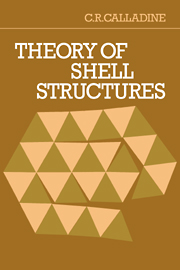Book contents
- Frontmatter
- Contents
- Preface
- List of symbols
- 1 Introduction
- 2 Generalised Hooke's law for an element of a shell
- 3 Cylindrical shells under symmetric loading
- 4 Purely ‘equilibrium’ solutions for shells: the membrane hypothesis
- 5 The geometry of curved surfaces
- 6 Geometry of distortion of curved surfaces
- 7 Displacements of elastic shells stressed according to the membrane hypothesis
- 8 Stretching and bending in cylindrical and nearly-cylindrical shells
- 9 Problems in the behaviour of cylindrical and nearly-cylindrical shells subjected to non-symmetric loading
- 10 Cylindrical shell roofs
- 11 Bending stresses in symmetrically-loaded shells of revolution
- 12 Flexibility of axisymmetric bellows under axial loading
- 13 Curved tubes and pipe-bends
- 14 Buckling of shells: classical analysis
- 15 Buckling of shells: non-classical analysis
- 16 The Brazier effect in the buckling of bent tubes
- 17 Vibration of cylindrical shells
- 18 Shell structures and the theory of plasticity
- Appendices
- Answers to selected problems
- References
- Index
- Frontmatter
- Contents
- Preface
- List of symbols
- 1 Introduction
- 2 Generalised Hooke's law for an element of a shell
- 3 Cylindrical shells under symmetric loading
- 4 Purely ‘equilibrium’ solutions for shells: the membrane hypothesis
- 5 The geometry of curved surfaces
- 6 Geometry of distortion of curved surfaces
- 7 Displacements of elastic shells stressed according to the membrane hypothesis
- 8 Stretching and bending in cylindrical and nearly-cylindrical shells
- 9 Problems in the behaviour of cylindrical and nearly-cylindrical shells subjected to non-symmetric loading
- 10 Cylindrical shell roofs
- 11 Bending stresses in symmetrically-loaded shells of revolution
- 12 Flexibility of axisymmetric bellows under axial loading
- 13 Curved tubes and pipe-bends
- 14 Buckling of shells: classical analysis
- 15 Buckling of shells: non-classical analysis
- 16 The Brazier effect in the buckling of bent tubes
- 17 Vibration of cylindrical shells
- 18 Shell structures and the theory of plasticity
- Appendices
- Answers to selected problems
- References
- Index
Summary
General remarks on shell structures
This book is about thin shell structures. The word shell is an old one and is commonly used to describe the hard coverings of eggs, Crustacea, tortoises, etc. The dictionary says that the word shell is derived from scale, as in fish-scale; but to us now there is a clear difference between the tough but flexible scaly covering of a fish and the tough but rigid shell of, say, a turtle.
In this book we shall be concerned with man-made shell structures as used in various branches of engineering. There are many interesting aspects of the use of shells in engineering, but one alone stands out as being of paramount importance: it is the structural aspect, and it will form the subject of this book.
Now the theory of structures tends to deal with a class of idealised or rarified structures, stripped of many of the features which make them recognisable as useful objects in engineering. Thus a beam is often represented as a line endowed with certain mechanical properties, irrespective of whether it is a large bridge, an aircraft wing or a flat spring inside a weighing machine. In a similar way, the theory of shell structures deals, for example, with ‘the cylindrical shell’ as a single entity: it is a cylindrical surface endowed with certain mechanical properties. This treatment is the same whether the actual structure under consideration is a gas-transmission pipeline, a grain-storage silo or a steam-raising boiler.
Information
- Type
- Chapter
- Information
- Theory of Shell Structures , pp. 1 - 11Publisher: Cambridge University PressPrint publication year: 1983
